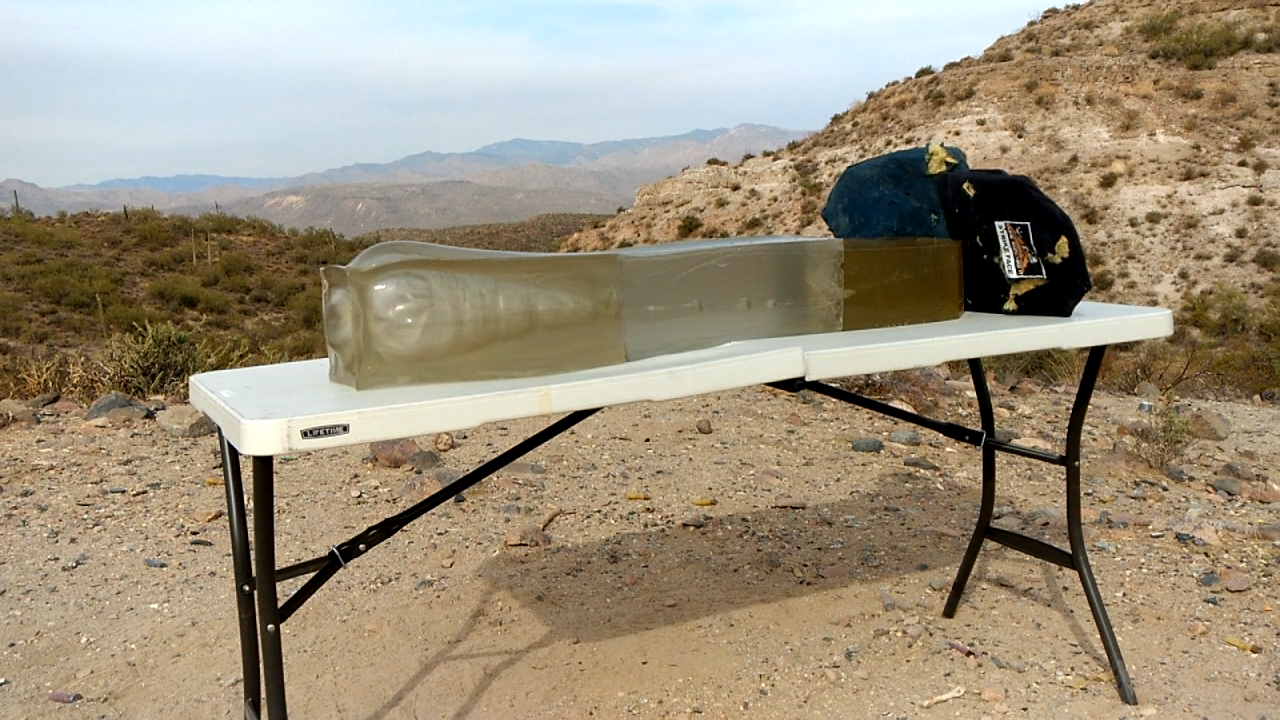If you aren’t already subscribed to us, you’re missing great content! Click here to subscribe.
The FK Brno 7.5mm Field Pistol is a high end boutique pistol based on the CZ75 and chambered in a rather intriguing proprietary cartridge. At first glance, it seems almost like 9x25mm Dillon, except necked down to .30 caliber, rather than .35 caliber. But it is longer than 9x25mm Dillon and 10mm Auto. Instead, it seems that it might be derived from their common parent case, the .30 Remington.
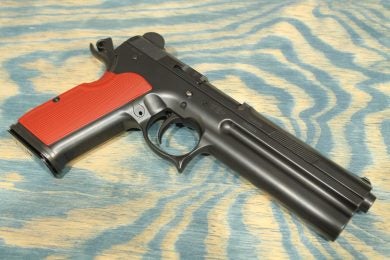
FK Brno 7.5mm Field Pistol
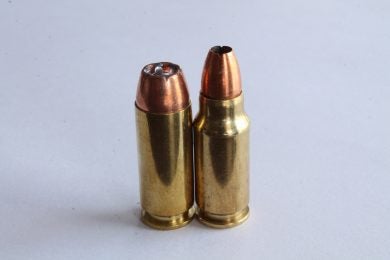
10mm Auto (L),
7.5mm FK (R)
It produces seriously impressive velocities at over 2,000 fps:
2,009
2,030
2,026
2,017
2,041
Average: 2,024.60
StdDev: 12.26
Min: 2,009
Max: 2,041
Spread: 32
So with these velocities, it ought to perform well against pistol rated armor, but I have been surprised before. Velocity is the primary factor in defeating pistol rated armor made of aramids, polyethylene, or steel. But bullet shape and integrity does play a role. This bullet has a somewhat rounded ogive and fragmented readily in ballistic gel. Will that have any impact on armor performance?
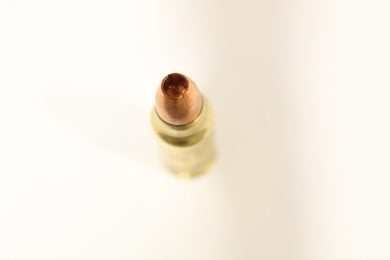
7.5mm FK
As it turns out, no. The 7.5mm honey badgered right through a level IIIA hard aramid plate like it wasn’t there. This is not indictment on the armor, of course. That same panel from that same manufacturer was able to stop .44 magnum and some pretty warm 10mm. But at 2,000fps, you’ll likely need legit, rifle rated armor to stop this cartridge.
So where does that put the pistol and the cartridge? The cartridge is seriously intriguing. I’m a sucker for innovation. A legit 2,000 fps in a “real” pistol is pretty neat. The ammo isn’t even ridiculously priced, all things considered. Sure, a buck per round is not cheap, but it’s also a brand new cartridge loaded with solid copper bullets. To keep it in perspective, compare it to .357 Sig defense loads with the Barnes TAC-XP.
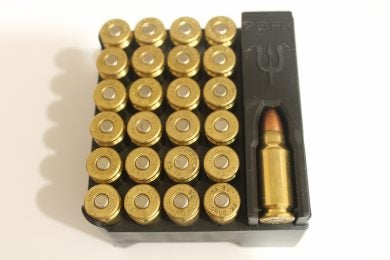
Pretty nifty packaging.
But that’s where things start to fall apart, if you’ll pardon the pun. FK chose to introduce this pistol and this cartridge with a load they dub “high terminal effect”. When we tested this ammo in ballistic gel it fragmented early and left a rather small, caliber sized track that continued on almost a yard.
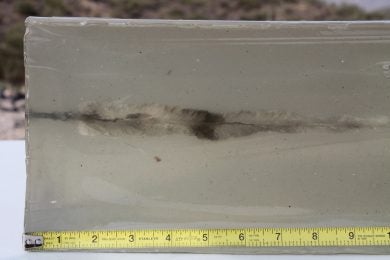
Fragmentation

Deep penetration
This performance is somewhat troublesome to quantify. On one hand, it isn’t great for a pistol because we don’t like to see fragmentation in pistol rounds. But the reason we don’t like to see fragmentation in pistol bullets is that it reduces weight, which tends to inhibit penetration and at normal pistol velocities, fragments tend not to deviate far from the primary track or substantively improve wounding. But at rifle velocities, fragmentation can initiate tears in tissue which are consequently exaggerated by the temporary stretch cavity. So it may be best to compare to intermediate rifle cartridges fired from a pistol or SBR. In that respect, the neck is a little long, though not terrible, at approximately 1.5″. The fragments that come off the main projectile are tiny and only get about an inch away from the primary track. The temporary stretch cavity is truly impressive, though.
But after the first 9″ or so, we are left with a .30 caliber sized wound track. That sounds worse than it is. Bear in mind that the closest comparison, solid copper hollow points in .300 AAC, also leave a big TSC, followed by a relatively small track. The difference is that a 110-120 grain .300 AAC solid copper HP tends to have an even larger and longer TSC and the lower velocity track is larger than caliber because those bullets expand and retain their petals, cutting a wider track.
No matter how well designed a bullet is, the majority of energy transfer and TSC will occur in the first few inches so it is important that the bullet is capable of cutting a wide track as it passes through tissue at lower velocity. At this point, it could be fairly considered to be a “normal” pistol bullet. So if we want to have our cake and eat it too, with a great deal of damage up front, combined with penetration that is adequate to reach vital organs, combined with a low velocity track that can actually put a decent sized hole in those vital organs, we need to use a projectile that expands and retains its weight. It also needs to limit expansion so that it doesn’t lose petals or produce so large a frontal area that penetration is inadequate.
So this particular load only falls short insofar as it penetrates more deeply than it really needs to for human defense and it does it with a caliber diameter projectile. This load could be a good choice for trail defense, where lots of disruption up front is desirable, but you may need to push really deep for bigger critters and you really have no idea what kind of critter might be a threat. It might also be useful for hunting hog and deer sized game.
But it is not ideal for personal defense against bipedal critters. Sure, it exceeds the FBI recommended max of 18″ and then some. On its own, I don’t consider that to be as much of a deal breaker as some do, though I understand concerns about over penetration. The real problem, in my assessment is that the bullet could have been designed more like a Barnes TSX so that it could expand properly, retain its weight, cut a wider track, and penetrate less.
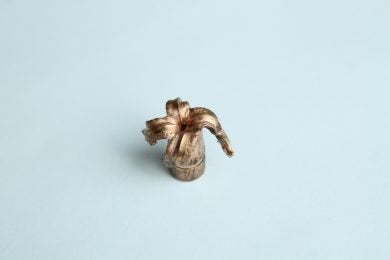
A Sig 120gr HT in .300 AAC, recovered from ballistic gel
I would have liked to see the debut of this cartridge with an expanding projectile with good weight retention and less than 20″ of penetration. That isn’t an insurmountable task, either. There are plenty of bonded lead core and solid copper hollow point projectiles that can hold together and expand well in this velocity range. Bottom line on the cartridge is that it has incredible potential for defensive use that wasn’t fully realized in this projectile design. Despite that shortcoming, this load is still rather impressive.
The pistol itself is expensive at $8,000 MSRP and I’m not convinced it earns that price tag. I don’t think I’ve ever seen an $8,000 pistol that wasn’t a Title II device, but I’ve handled plenty of $3,000 custom 1911s and the like. The fit and finish on the FK Brno is close. It is indeed quite finely made in some respects.
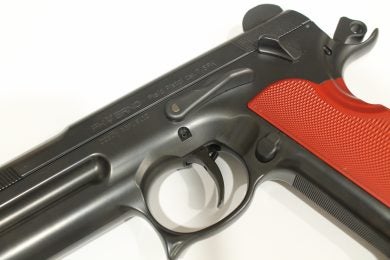
The FK Brno is indeed well built.
All edges are attractively radiused. The fit between parts is tight, and there isn’t any rattle when you shake it. It feels like one, homogeneous unit when the slide is in battery. The FK Brno feels good in the hand. It fits well, despite the long cartridge overall length and my stubby carny fingers. The extended slide stop and safety are easier to manipulate than the standard versions on other CZ clones and the CZ75 itself. The butterfly style sight is unusual but you can quickly adapt to it. With practice, it could give a great balance between speed and accuracy. You can focus on the front sight and roughly align with the rear for speed, or allow greater attention to rear sight alignment as time permits. If you are not fond of the sight, you can replace it with a more traditional notched rear or even a mount for a mini red dot.
But the trigger was suboptimal. It is indeed light and short, with a short reset, but it is not remotely the perfectly fitted and polished match trigger that I’d like to see on a handgun with this price tag. Every production Sig, Beretta, and yes, CZ that I’ve handled have a better trigger. I use those as examples because they have similar fire control mechanisms. So far as I know, the CZ75 should be virtually identical, though not quite interchangeable because of scale. Even my standard model polymer EAA Witness (Tanfoglio CZ75 clone) has a slightly better trigger. While it has a similar degree of take up and creep, the creep is smoother on the Witness. To be fair, the Witness could just feel better because it has been fired more, but the grittiness in this trigger actually reminds me of a Ruger P90 I owned years ago.
I’m aware that some could say that this is rather harsh criticism. If this was a new HK pistol with a $2,300 price tag, I might agree. But at this price, I believe that the gun deserves tight criticism. Keep that perspective in mind. If this were any other gun, I’d be more likely to overlook these minor issues or mention them only in passing. I really think this is close to being an amazing pistol and cartridge with a couple small tweaks. Overall, this really is a fantastic pistol and if it were priced less than a used late model Civic, I would seriously lust over one. Irrespective of price, if I was a movie villain, this would definitely be my gun.
Many THANKS to:
Proxibid: Shop For Home Defense Pistols Online Here
http://goo.gl/Mw54uT
Ventura Munitions: http://bit.ly/1LKxNRP
Please Support Them! They help make our videos possible.
Hoppe’s No. 9 Gun Bore Cleaner: A favorite since 1903
http:// www.hoppes.com
~~~~~~~~~~~~
Also, check out our Patreon page if you enjoy our program, and consider helping us at TFBTV out!
https://www.patreon.com/tfbtv
 Your Privacy Choices
Your Privacy Choices
